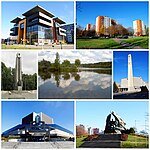Metal Mind Productions (MMP) is a Polish record label founded in 1987. The label focuses on rock and heavy metal. MMP is also publisher of Metal Hammer, the largest and the oldest heavy metal magazine. As a concert agency, it organises Metalmania, the largest heavy metal event in Central–Eastern Europe, and it organised over 1000 concerts, including Monsters of Rock in Poland, 1991.
Metal Mind Productions over the years became the subject of criticism from such bands as Malevolent Creation, Enter Chaos, Behemoth and Moonlight among others, for releasing unauthorized records and lack of professionalism. They purchased rights for several albums from Empire Records that include titles from such bands as Totem, Sammath Naur, Dissenter, Deivos, Archeon, Spinal Cord, Demise, Naumachia, and Pyorrhoea. and re-released them in 2007 and 2008 although the musicians were not been informed about the deal and were unable to contact Metal Mind.Metal Mind had a licensing deal with Music for Nations from the 1990s until its closure in 2004. That deal included releases by such bands as Candlemass, Thrasher, Dispatched and Paradise Lost among others. It also had a distribution and licensing deal with Century Media Records that included releases by such bands as Sentenced, Death, Cryptopsy, Arch Enemy, Strapping Young Lad, Jag Panzer, The Gathering, Bloodbath and Massacre among others.In 2006 Metal Mind Productions signed a multi-licensing deal with Roadrunner Records for their back catalogue. The selection of bands included Solitude Aeturnus, Willard, Trojan, Atrocity, Crimson Glory, Front Line Assembly, Violent Force, Acrophet, Amen, Atrophy, Heathen, Realm, Xentrix, Defiance, Disincarnate, Pestilence, Last Crack, Znowhite, Sadus, Toxik, Bulldozer and Gorguts.In 2008 the label signed a similar deal with Nuclear Blast for their back catalogue. The selection of bands include Brutallity, Control Denied, Darkane, Disbelief, Dismal Euphony, Destruction, Theatre of Tragedy, Stormwitch, Darkseed, Disharmonic Orchestra, Gardenian, Primal Fear, Farmer Boys, Horde, Hypocrisy, Impulse Manslaughter, Macabre, Mortification, Night in Gales, Slaughter, Abomination, Warhammer and Winter.On other various licenses Metal Mind Productions released albums by artists such as Ankh, Anvil, Art Rock, Astharoth, Bang Tango, Bank, Blaze Bayley, Believer, Warlock and Wilczy Pająk among others.In 2010 label founder Tomasz Dziubiński died of neoplasm.












